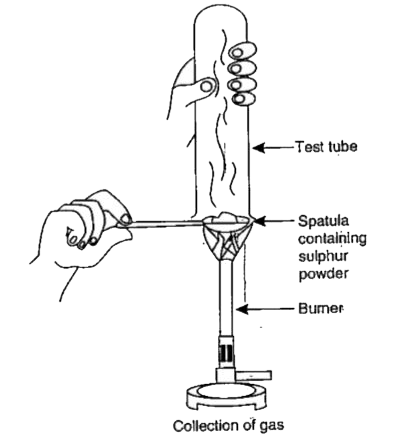Hydrous ferrous sulphate crystals are heated in a boiling tube for few seconds. Water droplets are seen in the inner sides of test tube and the colour of the crystals changes. On continuous heating a colourless gas X with smell of burning sulphur is evolved and a residue Y is obtained.
Write the balanced chemical equation for the above reaction.
To solve the problem, we need to write the balanced chemical equation for the reaction that occurs when hydrous ferrous sulfate (FeSO4·7H2O) is heated. Here's a step-by-step breakdown of the solution:
Step 1: Identify the Reactants
The main reactant is hydrous ferrous sulfate, which can be represented as:
FeSO4⋅7H2O
Step 2: Understand the Reaction
When hydrous ferrous sulfate is heated, it decomposes. The water of hydration is released first, which is why we see water droplets on the inner sides of the test tube. The decomposition leads to the formation of anhydrous ferrous sulfate (FeSO4) and the release of water vapor.
Step 3: Identify the Products
Upon further heating, the anhydrous ferrous sulfate decomposes into:
1. Ferric oxide (Fe2O3) - the residue (Y)
2. Sulfur dioxide (SO2) - the colorless gas (X)
3. Sulfur trioxide (SO3) can also be formed, but primarily SO2 is noted for its smell of burning sulfur.
Step 4: Write the Unbalanced Equation
The unbalanced equation for the decomposition can be written as:
FeSO4→Fe2O3+SO2+SO3
Step 5: Balance the Chemical Equation
To balance the equation, we need to ensure that the number of atoms of each element is the same on both sides.
1. Iron (Fe): There are 2 iron atoms in Fe2O3, so we need 2 FeSO4:
2FeSO4→Fe2O3+SO2+SO3
2. Sulfur (S): There are 2 sulfur atoms in 2 FeSO4, so we need to balance it with 1 SO2 and 1 SO3:
2FeSO4→Fe2O3+2SO2+SO3
3. Oxygen (O): Count the oxygen atoms:
- Left side: 8 from 2 FeSO4 (4 from each).
- Right side: 3 from Fe2O3, 4 from 2 SO2, and 3 from SO3, totaling 10.
After balancing the equation, we find:
2FeSO4→Fe2O3+2SO2+SO3
Final Balanced Equation
The final balanced equation is:
2FeSO4⋅7H2O→Fe2O3+2SO2+SO3+14H2O
The main reactant is hydrous ferrous sulfate, which can be represented as:
FeSO4⋅7H2O
When hydrous ferrous sulfate is heated, it decomposes. The water of hydration is released first, which is why we see water droplets on the inner sides of the test tube. The decomposition leads to the formation of anhydrous ferrous sulfate (FeSO4) and the release of water vapor.
Upon further heating, the anhydrous ferrous sulfate decomposes into:
1. Ferric oxide (Fe2O3) - the residue (Y)
2. Sulfur dioxide (SO2) - the colorless gas (X)
3. Sulfur trioxide (SO3) can also be formed, but primarily SO2 is noted for its smell of burning sulfur.
The unbalanced equation for the decomposition can be written as:
FeSO4→Fe2O3+SO2+SO3
To balance the equation, we need to ensure that the number of atoms of each element is the same on both sides.
2FeSO4→Fe2O3+SO2+SO3
2FeSO4→Fe2O3+2SO2+SO3
- Left side: 8 from 2 FeSO4 (4 from each).
- Right side: 3 from Fe2O3, 4 from 2 SO2, and 3 from SO3, totaling 10.
2FeSO4→Fe2O3+2SO2+SO3
The final balanced equation is:
2FeSO4⋅7H2O→Fe2O3+2SO2+SO3+14H2O
Topper's Solved these Questions
- DIKSHA QUESTIONS BOOK - OSWAL PUBLICATIONCHAPTER - DIKSHA QUESTIONS EXERCISE - CHEMICAL REACTION (MULTIPLE CHOICE QUESTION)
13 Videos
- DIKSHA QUESTIONS BOOK - OSWAL PUBLICATIONCHAPTER - DIKSHA QUESTIONS EXERCISE - ACIDS,BASES AND SALTS (VERY SHORT ANSWER)
5 Videos
- DIKSHA QUESTIONS BOOK - OSWAL PUBLICATIONCHAPTER - DIKSHA QUESTIONS EXERCISE - CHEMICAL REACTION (SHORT ANSWER)
20 Videos
- CHEMICAL REACTIONS AND EQUATIONSBOOK - OSWAL PUBLICATIONCHAPTER - CHEMICAL REACTIONS AND EQUATIONSEXERCISE - CASE-BASED MCQs
29 Videos
- METALS AND NON - METALS BOOK - OSWAL PUBLICATIONCHAPTER - METALS AND NON - METALS EXERCISE - CASE - BASED MCQs
29 Videos
Similar Questions
Hydrous ferrous sulphate crystals are heated in a boiling tube for few seconds. Water droplets are seen in the inner sides of test tube and the colour of the crystals changes. On continuous heating a colourless gas X with smell of burning sulphur is evolved and a residue Y is obtained.
Identify the gas X and the residue Y formed.
View SolutionHydrous ferrous sulphate crystals are heated in a boiling tube for few seconds. Water droplets are seen in the inner sides of test tube and the colour of the crystals changes. On continuous heating a colourless gas X with smell of burning sulphur is evolved and a residue Y is obtained.
What is the colour of the crystals before and after mild heating?
View Solution2 g of ferrous sulphate crystals are heated in a dry boiling tube.
Write the chemical equation for the reaction.
View Solution2 g ferrous sulphate crystals are heated in a dry boiling tube.
Write the chemical equation of the reaction
View Solution2 g of ferrous sulphate crystals are heated in a dry boiling tube.
Name the type of chemical reaction takes place.
View Solution2 g ferrous sulphate crystals are heated in a dry boiling tube.
Name the type of chemical reaction taking place.
View SolutionOn heating blue coloured powder of copper (II) nitrate in a boiling tube, copper oxide (black), oxygen gas and a brown gas X is formed.
Write a balanced chemical equation of the reaction.
View SolutionOn heating blue coloured powder of copper (II) nitrate in a boiling tube, copper oxide (black), oxygen gas and a brown gas X is formed.
Write a balanced chemical equation of the reaction.
View SolutionWhile performing an experiment, a student observes that when he heats some green crystals in a boiling tube, the colour of the crystals changes to brown and a gas evolves which smells like burning sulphur . Interpret the observations and results.
View SolutionSameer took sulphur powder on a spatula and heated it. He collected the gas evolved by inverting a test tube over it as shown in the figure.

Write a balanced chemical equation for the reaction taking place.
View Solution
